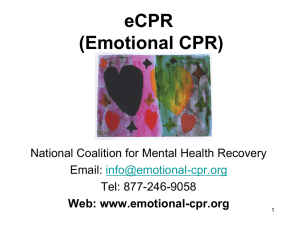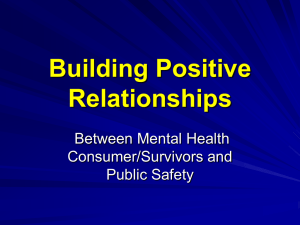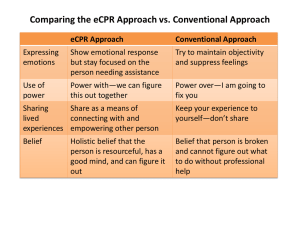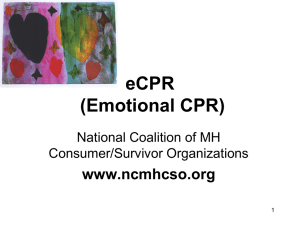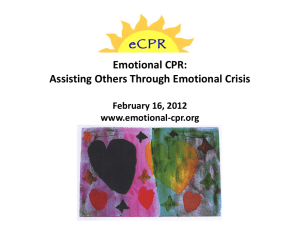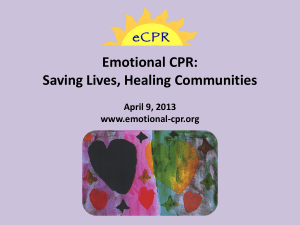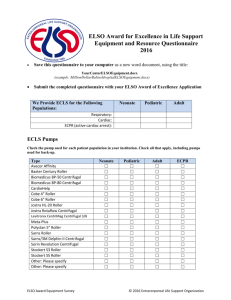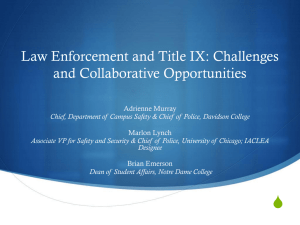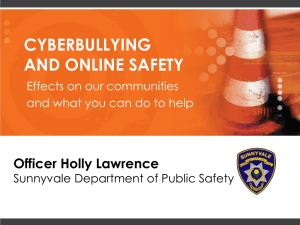Building-Partnerships-Stregthening-Communities
advertisement
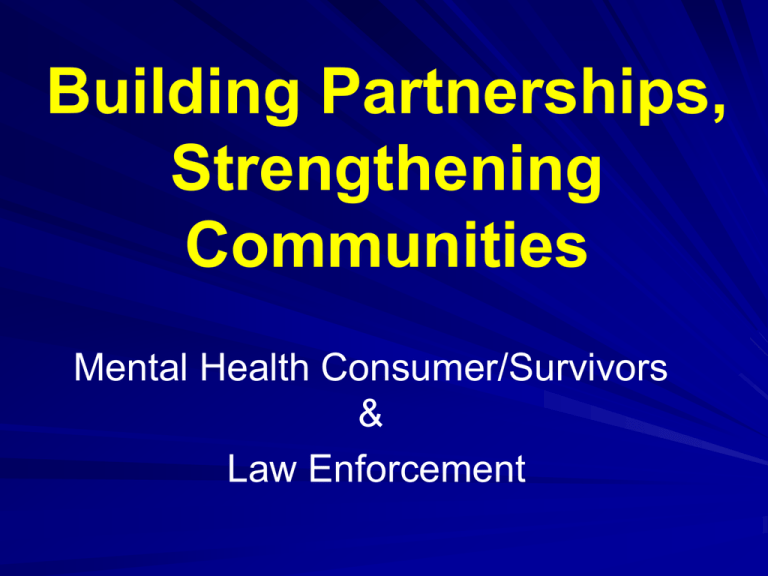
Building Partnerships, Strengthening Communities Mental Health Consumer/Survivors & Law Enforcement Building Partnerships, Strengthening Communities Welcome and Introductions Lessons Learned from Communities Emotional CPR (eCPR) Your concerns and your plans? Honoring what brought each of us into this room Who we are and how we got here Law Enforcement & Children’s Mental Health Roundtable Discussion (2007) National Federation of Families for Children’s Mental Health Conference (2007) International Association of Chiefs of Police’s National Policy Summit (2009) On-going work in each organization and amongst their local members Planning Develop trust with community and Police Decide the role of the Police Partner with mental health system Plan the training with community input Develop a CIT model for your needs Willingness for the training to evolve Lessons Learned 1. It takes collaboration and cooperation 2. It requires attention to everyone’s needs 3. It takes time – lot’s of time 4. There is no room for stereotypes 5. Know the systems and their rules! 6. Every person in every community has a role – go home and do something! Emotional CPR (eCPR) National Coalition for Mental Health Recovery 7 eCPR What is eCPR? a public health education program which prepares members of the public to assist a person who is experiencing an emotional crisis. Why eCPR: There is a vast and compelling need for the general public as well as law enforcement personnel to learn how to assist any person who is experiencing an emotional crisis. 8 The three elements of the practice of eCPR: C = Connecting with Compassion and Concern to Communicate P = emPowerment to experience Passion, Purpose and Planning R = Revitalize through Reestablishing Relationships, Routines and Rhythms in the community 9 eCPR is Based on the Values of a Healthy Community 1. Respectful, trusting relationships 2. Recovery is possible for everyone, centrality of hope 3. Self-determination (dignity of choice) is vital especially for persons in crisis 4. Connecting on a mutually respectful emotional level 5. Validity of emotional expression 6. Cultural attunement and inclusion across diverse groups 7. Every individual is appreciated as a healthy person inside who has encountered trauma 10 Being Prepared to Provide eCPR A. Taking care of ourselves, being centered, grounded, relaxed, in touch with our emotions. B. Learning to "be" with the strong emotions expressed by the person in distress and staying grounded and centered - Open our heart and our mind to what the person in distress is expressing. –Can we empathize? - Encourage self-expression - it is an essential component of the healing process. 11 Connecting Why is it important to be real? Genuineness helps rapport and relationship building. If you are not listening, and not authentic then you are not connecting. The person in crisis is aware of this, and it is not helpful. Your being real may be the most important tool you bring. •It is a way of being. • It gives the other person permission to calm down, feel safe, feel seen, feel validated. •We can be with people so their real selves are comfortable. •They get to focus on you the person, not the badge, uniform and gun belt. 12 Some Connecting Proficiencies a. Cultivating a hopeful and positive attitude towards the future (setting groundwork for moving forward) b. Creating an emotionally safe relationship and communicating care c. Listening fully and actively, and staying present on a deep level so you can support the person (use your investigation skills) 13 emPowerment The responder needs to be positive and hopeful and understand that: 1) If people in emotional crisis are effectively encouraged by the responder, they can access their power to make good choices. 2) People in emotional crisis are more capable and resourceful then they may appear. As the individual in emotional crisis begins to feel safe and is able to communicate they begin making plans and thinking more clearly. 14 Some emPowering Proficiencies a. Demonstrating a capacity to enter into a collaborative “power with” as opposed to “power over” b. Facilitating the other person’s access to his or her inner wisdom c. Sensitively reframing crisis as opportunity d. Facilitating the person’s planning ability ~~~~~ It’s crucial that the planning stage be focused on specifics. Some examples of what you might asking the person: How can I help you feel safe? What would help you feel better? What do you do to take good care of yourself? Who can I help you connect with or talk to? What’s the next important thing you or I can do now? 15 Revitalizing Proficiencies a. Meaning: Helping people to identify the vital center that brings meaning and purpose to their lives. b. Dreams: Encouraging people to take small steps in the direction of their dreams and goals. c. Relationships: Facilitating connections in the community to enhance or re-establish roles, relationships, and routines. 16 R = Revitalize Encourage the person to begin to engage in relationships, to resume or begin roles in their family, with friends, or in the community. Emotional distress provides people with an opportunity to make a change in their life. It may be a time of searching for new meaning or purpose which may help them stay in a positive (non-crisis) state of being longterm. 17 eCPR compared with traditional law enforcement approach eCPR Approach Law Enforcement Approach Accessible Lay language, culturally attuned Professional terms, culturalcentric Uses of Power Power with; we can figure this out together Power over; I am going to fix the person or problem. Belief The person is a whole human being and with assistance can figure it out Belief that person is broken, and can not figure out what to do without professional help. Use of labeling and categories Avoided Recommended Coercion Minimizing trauma, typically seen as not necessary. Exercised, seen as necessary Fear Fear is diminished by being in relationship Fear is managed by LE via exercising presence of being in charge. Your Concerns? Your Plans? Have you gleaned any new insights or inspiration here today? What are you going to do with this information when you go home? What help will you need? Resources Law Enforcement and Children’s Mental Health Roundtable Discussion: Executive Summary (2007) How to Work Effectively with Police When Youth are in Mental Health Crisis: A Guide for Families of Children and Youth with Mental, Emotional, or Behavioral Health Problems (2008) Building Safer Communities: Improving Police Response to Persons with Mental Illness (2010) Find these and other resources at www.ffcmh.org and www.theiacp.org Contact Information A. Elaine Slaton National Federation of Families for Childrens Mental Health www.ffcmh.org Eslaton@ffcmh.org 240-403-1904 (direct line) Lauren Spiro National Coalition for Mental Health Recovery, www.ncmhr.org; www.emotional-cpr.org, Laurenspiro1@gmail.com, 703-862-6512 (cell) Mike Sullivan Michael Sullivan ADA Consulting www.michaelsullivanadaconsulting.com, michaelsullivanadaconsulting@yahoo.com, 707-849-9565 (cell)
